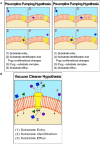The Role of Eukaryotic and Prokaryotic ABC Transporter Family in Failure of Chemotherapy
- PMID: 28119610
- PMCID: PMC5223437
- DOI: 10.3389/fphar.2016.00535
The Role of Eukaryotic and Prokaryotic ABC Transporter Family in Failure of Chemotherapy
Abstract
Over the years chemotherapy failure has been a vital research topic as researchers have been striving to discover reasons behind it. The extensive studies carried out on chemotherapeutic agents confirm that resistance to chemotherapy is a major reason for treatment failure. "Resistance to chemotherapy," however, is a comprehensive phrase that refers to a variety of different mechanisms in which ATP-binding cassette (ABC) mediated efflux dominates. The ABC is one of the largest gene superfamily of transporters among both eukaryotes and prokaryotes; it represents a variety of genes that code for proteins, which perform countless functions, including drug efflux - a natural process that protects cells from foreign chemicals. Up to date, chemotherapy failure due to ABC drug efflux is an active research topic that continuously provides further evidence on multiple drug resistance (MDR), aiding scientists in tackling and overcoming this issue. This review focuses on drug resistance by ABC efflux transporters in human, viral, parasitic, fungal and bacterial cells and highlights the importance of the MDR permeability glycoprotein being the mutual ABC transporter among all studied organisms. Current developments and future directions to overcome this problem are also discussed.
Keywords: ABC family; BCRP1; chemotherapy efflux; chemotherapy failure; multiple drug resistance; p-glycoprotein.
Figures



Similar articles
-
β-carotene reverses multidrug resistant cancer cells by selectively modulating human P-glycoprotein function.Phytomedicine. 2016 Mar 15;23(3):316-23. doi: 10.1016/j.phymed.2016.01.008. Epub 2016 Feb 6. Phytomedicine. 2016. PMID: 26969385
-
Multidrug resistance: molecular mechanisms and clinical relevance.Cancer Chemother Pharmacol. 1997;40 Suppl:S3-8. doi: 10.1007/s002800051053. Cancer Chemother Pharmacol. 1997. PMID: 9272126 Review.
-
Mammalian drug efflux transporters of the ATP binding cassette (ABC) family in multidrug resistance: A review of the past decade.Cancer Lett. 2016 Jan 1;370(1):153-64. doi: 10.1016/j.canlet.2015.10.010. Epub 2015 Oct 20. Cancer Lett. 2016. PMID: 26499806 Review.
-
Understanding of human ATP binding cassette superfamily and novel multidrug resistance modulators to overcome MDR.Biomed Pharmacother. 2018 Apr;100:335-348. doi: 10.1016/j.biopha.2018.02.038. Epub 2018 Feb 16. Biomed Pharmacother. 2018. PMID: 29453043 Review.
-
Tackling drug resistance with efflux pump inhibitors: from bacteria to cancerous cells.Crit Rev Microbiol. 2019 May;45(3):334-353. doi: 10.1080/1040841X.2019.1607248. Epub 2019 Jun 28. Crit Rev Microbiol. 2019. PMID: 31248314 Review.
Cited by
-
Inhibitor-Resistant Mutants Give Important Insights into Candida albicans ABC Transporter Cdr1 Substrate Specificity and Help Elucidate Efflux Pump Inhibition.Antimicrob Agents Chemother. 2022 Jan 18;66(1):e0174821. doi: 10.1128/AAC.01748-21. Epub 2021 Nov 15. Antimicrob Agents Chemother. 2022. PMID: 34780272 Free PMC article.
-
In vitro and in vivo Efficacy of a Synergistic Combination of Itraconazole and Verapamil Against Aspergillus fumigatus.Front Microbiol. 2019 Jun 7;10:1266. doi: 10.3389/fmicb.2019.01266. eCollection 2019. Front Microbiol. 2019. PMID: 31231346 Free PMC article.
-
Drug Delivery Systems of Natural Products in Oncology.Molecules. 2020 Oct 6;25(19):4560. doi: 10.3390/molecules25194560. Molecules. 2020. PMID: 33036240 Free PMC article. Review.
-
Characterization and phylogenetic analysis of multidrug-resistant protein - encoding genes in Trypanosoma evansi isolated from buffaloes in Ngawi district, Indonesia.Vet World. 2019 Oct;12(10):1573-1577. doi: 10.14202/vetworld.2019.1573-1577. Epub 2019 Oct 17. Vet World. 2019. PMID: 31849418 Free PMC article.
-
Recent Advancements and Strategies for Overcoming the Blood-Brain Barrier Using Albumin-Based Drug Delivery Systems to Treat Brain Cancer, with a Focus on Glioblastoma.Polymers (Basel). 2023 Oct 2;15(19):3969. doi: 10.3390/polym15193969. Polymers (Basel). 2023. PMID: 37836018 Free PMC article. Review.
References
-
- Abolhoda A., Wilson A. E., Ross H., Danenberg P. V., Burt M., Scotto K. W. (1999). Rapid activation of MDR1 gene expression in human metastatic sarcoma after in vivo exposure to doxorubicin. Clin. Cancer Res. 5 3352–3356. - PubMed
-
- Akhdar H., Legendre C., Aninat C., Morel F. (2012). Anticancer Drug Metabolism: Chemotherapy Resistance and New Therapeutic Approaches. Rijeka: INTECH Open Access Publisher, 138–170.
Publication types
LinkOut - more resources
Full Text Sources
Other Literature Sources

